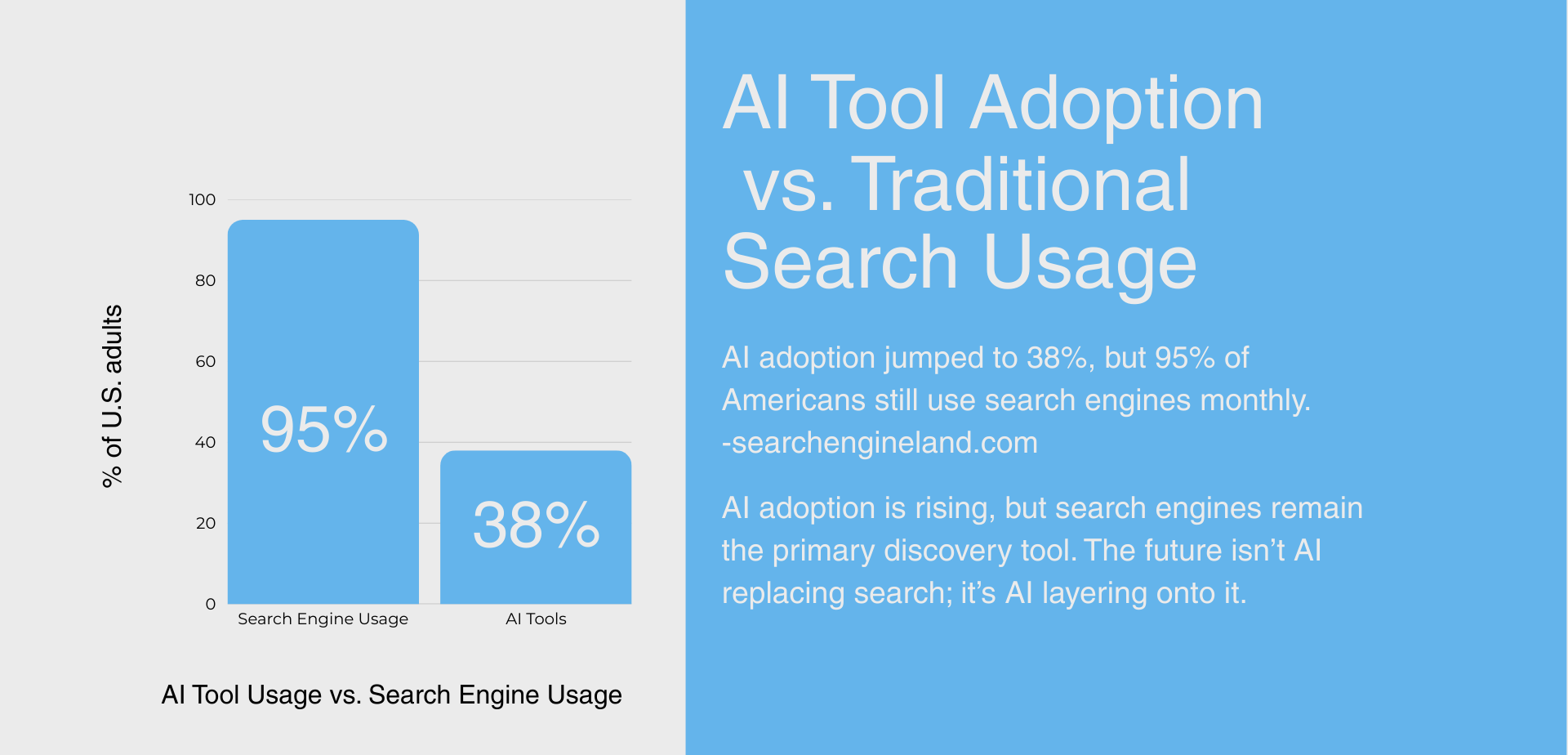AI Search Optimization for Small Businesses
Search is changing fast. It’s no longer just about keywords and backlinks. It’s about how AI understands, summarizes, and surfaces content.
As AI tools (ChatGPT, Gemini, Perplexity, etc.) become part of how people discover answers, small businesses need to optimize not just for Google, but for AI search too. Getting left behind means fewer leads, fewer clicks, and less visibility, despite having great content.
In this post, you’ll learn what AI search optimization is, why it matters for small businesses, and exactly how to make your website ready for AI visibility.
What Is AI Search Optimization?
AI Search Optimization (sometimes called “Generative Engine Optimization” or GEO) means adjusting your website, content, and SEO strategy so AI-powered search tools like ChatGPT, Gemini, and Perplexity can easily understand, summarize, and cite your content are more likely to:
Cite your content as a trustworthy source
Summarize or answer questions using your content
Pull in your FAQ or structured information in responses or features
It goes beyond traditional SEO. It’s about answering intent, providing clear, structured content, and making your site machine-readable by AI models.
Why AI Search Matters for Small Businesses
AI is changing how people search — shifting from keyword lists to conversational answers. There are several reasons small businesses should care, including greater visibility, cost savings, and the chance to compete with larger brands in AI search results.
AI tools often pull from credible sources, and if your site is well optimized, you can be one of them. According to Writesonic, smaller websites can get a greater percentage of AI-traffic compared to larger domains under the right conditions.
AI search changes how people look for answers: more conversational queries, more voice search, more dependency on summaries, not just lists of pages. How to Optimize Website for AI Search by Sovic Creative highlights that context, clarity, and structural organization are key for AI visibility.
For small businesses, AI optimization can save time and stretch marketing dollars. Tools and automation help with keyword research, content structure, metadata, schema — all things that used to require advanced SEO expertise.
Key Strategies for AI Search Optimization
Like any marketing strategy, small businesses need to take a methodical approach with AI Search. Let’s define the actionable steps you can use.
Write in a Conversational, Question-Answer Style
When you’re creating content you hope will be crawled and used by AI and LLMs, you still need to keep your target demographic in mind. In short, write like a human for a human audience. To accomplish that, consider the following:
Break down content into clear sections with headings that resemble real questions people might ask.
Use FAQ sections.
Use “You” language. Example: instead of “Benefits of HVAC maintenance,” write “What are the benefits of regular HVAC maintenance?”
Guides such as Text.com’s piece on Answer Discovery Queries show that writing in Q&A style improves your chances of being featured in AI-generated answers.
Use Structured Data and Schema Markup
Implement FAQ schema, Article schema, LocalBusiness schema, and Review schema. Structured data helps AI systems understand your content’s context and pull features or snippets.
Agility CMS’s guide explicitly recommends cleaning metadata, using proper schema, and H1→H2→H3 hierarchy.
Organize Site Structure & Internal Linking
Create logical site maps. Group pages by topic clusters. Ensure that important content is not buried. Use descriptive URLs and anchor texts.
Zenergy Works notes that content semantically grouped and easily discoverable helps AI index better.
Produce Relevant, Authoritative, and Fresh Content
AI favors content that is recent and trusted. This means:
Updating old content
Publishing new posts or guides that address current questions
Adding original insights, data, or case studies if you can. Writesonic points out that sites with unique content get cited more.
Improve Technical Site Performance & UX
Fast load times, mobile responsiveness, accessibility, minimal JavaScript for critical pages, secure (HTTPS). AI and users both value speed and smooth navigation. Fireflex blog’s “How to Optimize Inner Website” reminds small businesses that site experience and accessibility are not optional in AI SEO.
Monitor AI Visibility & Adapt
Use tools that track whether your content is being cited by AI models. GEO tools, AI search visibility dashboards, or specially designed analytics.
Writesonic, for example, offers tools that track when your content is cited in AI platforms.
Common Objections
-
Many AI-SEO improvements are incremental and affordable. Start small—add FAQ schema, update existing content, optimize titles, and clean up page speed. These changes compound over time.
-
AI doesn’t eliminate SEO; it changes it. Traditional SEO fundamentals (good content, links, speed) still matter. AI optimization builds on top of those, not replaces them.
-
Reframe: New tools are emerging (GEO, AI visibility monitoring). Also, by tracking indirect metrics like brand mentions, organic traffic lifts, and user engagement, you get signals even if direct AI referral is hard to measure.
Which Businesses Benefit Most? (Personas + Use Cases)
Theories and hypotheticals are nice. But as a small business, you need to see how the rubber meets the road.
So, here’s how this works in the real world.
HVAC Company (Local Service)
Pain: Competing with big directories.
Play: Create question-based service pages (“How often should I service my AC?” “What size unit do I need?”) with clear answers, local schema, and a price-range explainer.
Outcome: More AI-driven citations for local intent and “near me” queries.
Take a look at What Are Marketing Personas: 7 Reasons You Need to Know and How to Create a Marketing Persona.
Florist (Local Retail + Seasonal Demand)
Pain: Seasonal spikes and generic answers dominate.
Play: Build seasonal FAQ hubs (“What flowers last longest in heat?” “Best bouquet for hospital delivery?”), add product schema to top SKUs, and publish “order by” cutoff times.
Outcome: AI pulls precise, local, time-sensitive answers—more orders on peak days.
Boutique Law Firm (Specialized Services)
Pain: Complex topics overwhelm readers.
Play: Break down one niche topic per page with a plain-English definition, 3–5 FAQs, and a “What to do next” checklist.
Outcome: AI cites your clear, short answers and your site earns more qualified consultations.
Check out our Brand Messaging Guide to make your AI SEO strategy even stronger.
How Does AI Search Differ from Traditional SEO?
Traditional SEO tries to rank pages. AI search tries to answer questions. That shifts how you write and structure content.
Short, direct answers. Clear headings. Strong internal linking. Helpful examples. Schema markup. These elements make your page the easiest source to quote.
How to Begin AI SEO: Step-By-Step Plan
If your small business is going to make AI SEO work, you need a plan.
Audit what you already have
Identify your highest-traffic content.
Look for content with outdated info.
Check site speed, mobile view, schema presence.
Keyword & Intent Research for AI
Use tools (e.g. AnswerThePublic, “People Also Ask,” forums) to find conversational queries.
Identify local conversational search phrases, voice-search terms.
Optimize key pages
Choose 2–3 pillar pages to upgrade (add FAQ, schema, better headings).
Refresh metadata and make content directly answer potential questions.
Add structured content
FAQs, how-to guides, glossaries.
Ensure they are well-linked and easily found on the site.
Optimize technical performance
Ensure mobile friendliness.
Improve load speed.
Ensure site security (HTTPS).
Monitor & Iterate
Use analytics and AI-tracking tools.
Review performance monthly.
Adjust based on what AI is “pulling” from your site: which questions, which pages.
Before vs. After: What an AI-Friendly Section Looks Like
Let me show you an example using an HVAC company.
Before (Hard to Quote)
We offer comprehensive cooling services with unmatched expertise and value across all major brands, ensuring satisfaction and comfort all summer long.
After (Easy to Quote)
Question (the query typed into the LLM): How often should I service my AC?
Direct Answer: Service your AC once per year, ideally in spring, to keep efficiency high and prevent breakdowns.
Details: Annual checks catch coolant issues, dirty coils, and worn parts before peak heat.
What to do next: Book a spring tune-up and replace your filter every 2–3 months.
The “After” format gives AI a clean, direct citation target.
What’s Next? The Future of AI Search & How Small Businesses Stay Ahead
AI search is evolving fast. And if you don’t adapt, you’ll get left behind.
Here’s where things are headed — and what small businesses should do now to stay ahead of the curve.
Predictions for AI Search
1. Multimodal Answers Become Standard
AI will increasingly pull from not just text, but images, video, audio, and even charts. That means your content will need to be rich in multiple formats: alt text, transcripts, embedded videos, infographics.
2. Hyperlocal and Contextual Answers Will Rise
AI will get better at understanding context—location, time, prior queries—to deliver precisely relevant local answers. Queries like “best HVAC near me open now” may first show AI-summarized answers with your business if you optimize for local and real-time context.
3. AI Summaries Will Cite and Rank Differently
Instead of “rankings,” AI may shift to “citing authority” — meaning pages that are consistently cited by AI for answers get more weight over time. Backlinking may evolve into “AI citation networks.”
4. Conversational Search Chains and Follow-Ups
Users will ask follow-up questions in a chain. AI systems will expect your content to answer tiered queries. Pages optimized for layered Q&A (question → subquestion → depth) will perform better.
5. User Trust & Verification Becomes Core
As AI answers proliferate, users will demand provenance: How do you know this answer is correct? Businesses that provide clear source attribution, transparency, and freshness signals will outperform.
6. AI SEO Tools Will Become Mainstream
Tools that scan pages for AI-readiness (schema coverage, Q&A structure, answer density) will become routine in marketing stacks. Even small businesses will have “AI audits” alongside SEO audits.
How Small Businesses Can Future-Proof Now
As I mentioned above, if you don’t adapt, you’ll be left behind. Here is what small businesses can do to stay up to date with GEO.
1. Start publishing in multimodal formats
Add images, charts, transcripts, and videos alongside your content.
2. Build deep also-asked structures
Use core questions + layered sub-questions to anticipate follow-ups.
3. Create a local AI content layer
For example, “Today’s hours,” “Callouts for neighborhood queries,” “Same-day availability.”
4. Cite sources & dates
Show “Last updated: [date]” and link to data you used.
5. Run AI citation experiments.
SEO and especially GEO is not a set it and forget it strategy. Update 1–2 pages a month and watch whether AI tools begin citing your content.
6. Train your team or hire for AI readiness
Having someone who understands AI search strategy will become a competitive edge.
Here’s the takeaway: The future favors clarity, depth, and content that anticipates not just the question, but the follow-ups. The businesses that build with that mindset today will appear as the answers tomorrow.
Frequently Asked Questions
-
Generative Engine Optimization, or GEO, is the practice of optimizing your content so that AI-powered search tools like ChatGPT, Perplexity, or Google’s Search Generative Experience (SGE) can easily find, understand, and summarize it. Think of it as SEO for AI — making sure your site is clear, structured, and trustworthy so AI engines cite your content when answering user questions.
-
Traditional SEO focuses on ranking pages in search results. AI search focuses on answering questions directly. Instead of sending people to a list of links, AI summarizes the best content into one response. This means your content has to be structured in ways that make it easy for AI systems to recognize, extract, and use.
-
Yes. Voice search queries are typically conversational (“What’s the best plumber near me?”), and this aligns closely with how AI search engines process questions. If your content is written in a natural, Q&A style, it’s more likely to show up in both AI summaries and voice search results.
-
Like traditional SEO, results take time. For most small businesses, you can start seeing improvements within 3–6 months if you’re actively optimizing content, adding FAQs, and improving site structure. AI search is still evolving, so being early gives you an advantage that compounds over time.
-
Potentially. If you strip out all personality and try to write only for machines, your content can become robotic. The key is balance: structure your posts with clear headings, schema, and FAQs, but keep your brand voice intact. That way, both AI systems and human readers will value your content.
Are You AI Search Ready?
Conclusion: Getting Ahead of the Shift
AI search is no longer optional. It’s not just about being found—it’s about being cited, trusted, and selected by AI as a source. For small businesses, this is an opportunity: lean, local, relevant content can win in AI-search visibility—often more so than big brands.
By applying structured content, schema, conversational tone, and authoritative content, you improve your chances of being part of the AI answers people see.
If you want help auditing your site for AI readiness, optimizing content, or setting up tracking—let's connect.

Author: Noah Swanson
Noah Swanson is the founder and Chief Content Officer of Tellwell.








